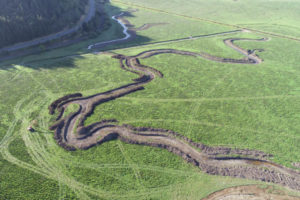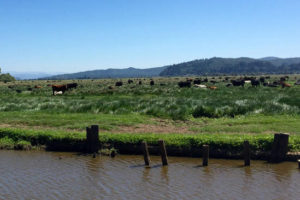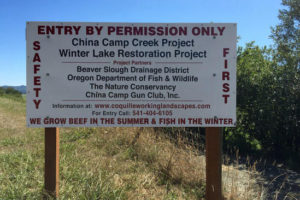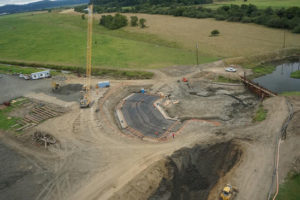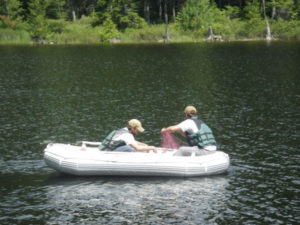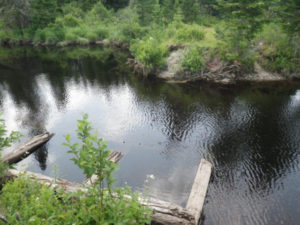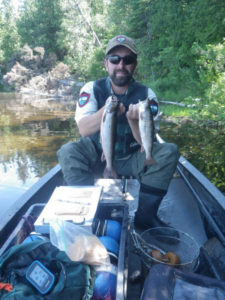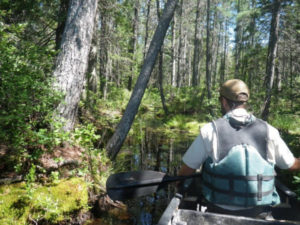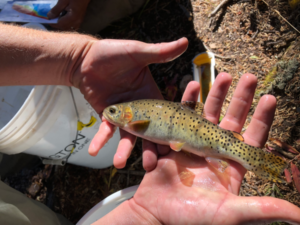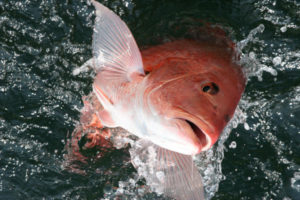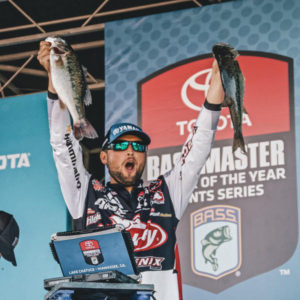Efforts Continue to Reintroduce Arctic Grayling in Michigan
By MAKENZIE SCHROEDER
Michigan Department of Natural Resources
from The Fishing Wire
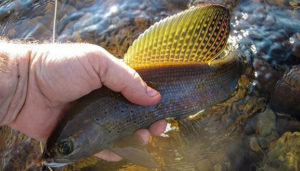
Michigan Grayling
It’s been a little over two years since the Michigan Department of Natural Resources, in partnership with the Little River Band of Ottawa Indians, announced a new initiative to bring back a long-gone historical species – Arctic grayling – to the Great Lakes state.
Michigan’s Arctic Grayling Initiative – with more than 45 partners, including state and tribal governments, nonprofit organizations, businesses and universities – is committed to reintroducing this culturally significant species, with steady progress made since June 2016.
“Our formal mission as an initiative is to restore self-sustaining populations of Arctic grayling within its historic range in Michigan,” said DNR Fisheries Division Assistant Chief Todd Grischke.
Michigan’s history with the Arctic grayling is long and storied. A striking fish with a sail-like dorsal fin and a slate blue color on its body, it was virtually the only native stream salmonid (a family of fish that also includes salmon and trout) in the Lower Peninsula until the resident population died off nearly a century ago.
“The fact we have a town named after this fish indicates just how iconic it was, and still is, to many in this state,” Grischke said. “When you add in other factors – such as the fact they’re only native to Michigan and Montana out of all the lower 48 states – it just adds to their legendary status.”
In the 19th century, Arctic grayling were found in many coldwater streams in Michigan’s northern Lower Peninsula and in one Upper Peninsula stream – and large populations of grayling flourished in the Manistee and Au Sable rivers – offering anglers plenty of opportunity to catch these unique fish.
But a variety of factors slowly erased their presence, including the cutting of Michigan’s vast virgin forest in the 1800s.
“Logging practices during that time period used streams to transport trees that were harvested. The streams carried logs to mills for processing,” explained Grischke. “These practices greatly impacted the physical nature of those streams and basically destroyed stream habitats for fish, including grayling spawning areas.”
Additionally, the cutting of the trees caused blockages in many of those same streams, often displacing grayling from where they lived, but this was just one issue that affected Michigan’s Arctic grayling, another being the introduction of non-native fish species.
“Other types of trout were introduced into Michigan’s waters to create additional opportunities for anglers to pursue – but a consequence of this action was that grayling couldn’t compete with more aggressive fish like brown, rainbow or brook trout,” Grischke said.
The other factor that led to the species’ demise was overfishing, as people harvested grayling in large quantities with no possession limits or other regulations to stop them.
The last native Arctic grayling on record in Michigan were caught in 1936. Since that time, natural resource managers have repeatedly looked for options to reintroduce the species.
“In the late 1800s and early 1900s they tried stocking millions of Arctic grayling fry into Michigan streams, but that didn’t work,” said Grischke. “And then in the 1980s we, the DNR, stocked hatchery-reared yearlings into lakes and streams, but again to no avail.”
In each of these previous reintroduction efforts, something critical was missing that prevented these populations from flourishing, but the Michigan Arctic Grayling Initiative hopes to rectify that.
“We have learned from the previous reintroduction events and plan to capitalize on new approaches, dedicated partnerships and advanced technology,” Grischke explained.
Much of the initiative’s focus is detailed in its official action plan, reflective of the vast work to be done by various partners.
The group is gleaning as much information as possible from the state of Montana and its successful effort at re-establishing stable Arctic grayling populations. In addition to Michigan receiving help from biologists in Montana, both states also have been collaborating with Alaska.
“Within our action plan we’ve identified four focus areas and associated goals that were developed by all the partners and that we believe will give us the best chance of success moving forward,” said Grischke.
The four focus areas of the action plan are research, management, fish production, and outreach and education.
The research focus area includes work – already under way – on understanding relationships between resident trout and grayling, prioritizing streams for grayling introduction and evaluating in-stream remote site incubators. These incubators allow fish to be reared and released directly in the streams to better allow them to imprint to the waters they hopefully will reproduce in later.
Better imprinting means the initiative will be one step closer to establishing a self-sustaining population of Arctic grayling, which is the ultimate outcome of this effort.
The cost to reintroduce the fish will total around $1.1 million, according to DNR Fisheries Division Chief Jim Dexter, with virtually the entire amount being supplied through private and foundation support.
To date, nearly $325,000 has been raised for the initiative. Contributors include the Consumers Energy Foundation, the Henry E. and Consuelo S. Wenger Foundation, Rotary Charities of Traverse City, Petoskey-Harbor Springs Area Community Foundation, Oleson Foundation and Little Manistee River Watershed Conservation Council. Plans are under way to recognize donors at Oden State Fish Hatchery.
“A diverse group of partners has invested themselves toward attaining a shared goal, and that says something about the nature of this project,” said Dexter.
Funders are critical in financially supporting various projects within the initiative.
“I am delighted to play a role in returning the Arctic grayling to northern Michigan’s streams,” said Charles Wilson, a member of the Henry E. and Consuelo S. Wenger Foundation’s board. “There has been a void in Michigan’s biotic community for way too long, but thanks to knowledge gained from Montana’s experience and research performed elsewhere, a reasonable chance exists today for successful reintroduction.”
Goals for the management focus area will include evaluating key habitat criteria, establishing population goals, and working on regulations related to fishing for grayling.
The fish production focus area’s work will center on experimenting with remote site incubator designs, ensuring fish health standards are upheld and maintaining a genetically diverse broodstock (fish used for breeding purposes) that will be housed at a hatchery facility.
Lastly, goals for the outreach and education focus area will be concentrated on informing the public about this initiative’s efforts, identifying future partners and creating a stewardship plan.
“The goals of these focus areas will be accomplished by partner representatives working together,” Grischke shared. “The only way this initiative will be successful is if we continue to work together towards our mission.”
To learn more about the Michigan Arctic Grayling Initiative, visit migrayling.org.
Check out previous Showcasing the DNR stories in our archive at michigan.gov/dnrstories. To subscribe to upcoming Showcasing articles, sign up for free email delivery at michigan.gov/dnr.
